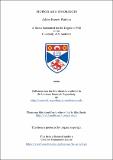Fiction and its objects
View/
Date
22/06/2020Author
Supervisor
Keywords
Metadata
Show full item recordAltmetrics Handle Statistics
Altmetrics DOI Statistics
Abstract
This thesis develops a metaphysics of fictional objects that is embedded in a theory of fictional practice and maximally preserves the meanings of our fictional utterances. I begin by asking two questions: How can it be true of a fictional object such as Dune's Paul Atreides that he was born on the planet Caladan to the Lady Jessica (an intrafictional claim), that he was created on Earth by Frank Herbert (an extrafictional claim), and that he does not exist (a nonexistence claim)? If one or more of these is not true, then what is the nature of our assent to these three types of propositions about fictional objects? I argue that fiction's social nature and its basis in imaginative acts provides us with a dualist account of fictional objects: 'Paul Atreides' in the intrafictional and nonexistence claims refers to merely possible people while 'Paul Atreides' in extrafictional claims refers to an actual abstract artifact. I defend imagination's central role in fiction and argue that it's a norm of imagination that it models possibilities. I then define fiction as a social practice necessarily consisting in 1) acts of social imagining, 2) agreement maintained by implicit principles, 3) an aesthetic function or aim, and 4) the creation of abstract artifacts through which it achieves that aim. The result is that intrafictional claims are not assertions about the actual world, but expressions of imaginings that have as their intentional objects possible objects and states of affairs. Extrafictional claims are assertions about the actual abstract artifacts created by fictional practice that bear a picking out relation to the possibilia of fictive imaginings. Finally, nonexistence claims are assertions about the possibilia of our fictive imaginings - assertions that they are not actual. I defend the compatibility of these artifactualist and possibilist accounts and show how their union under the umbrella of a full theory of fiction both explains their intuitive appeal and solves the major issues they encounter individually.
Type
Thesis, PhD Doctor of Philosophy
Rights
Creative Commons Attribution-NonCommercial-NoDerivatives 4.0 International
http://creativecommons.org/licenses/by-nc-nd/4.0/
Collections
Except where otherwise noted within the work, this item's licence for re-use is described as Creative Commons Attribution-NonCommercial-NoDerivatives 4.0 International
Items in the St Andrews Research Repository are protected by copyright, with all rights reserved, unless otherwise indicated.


